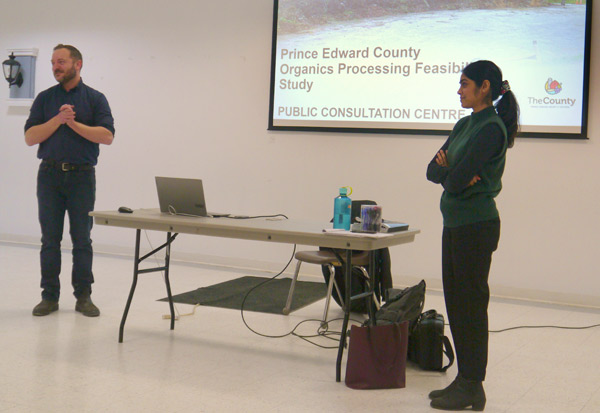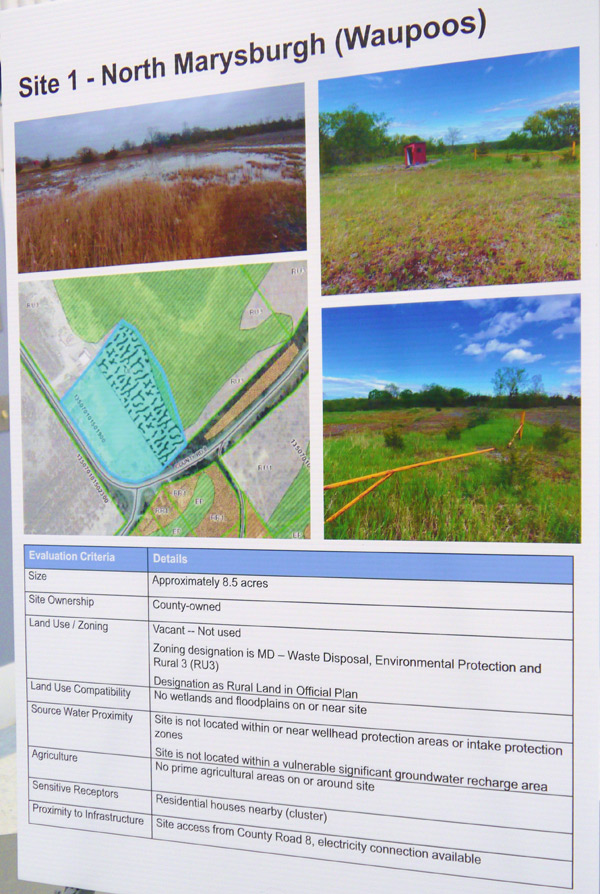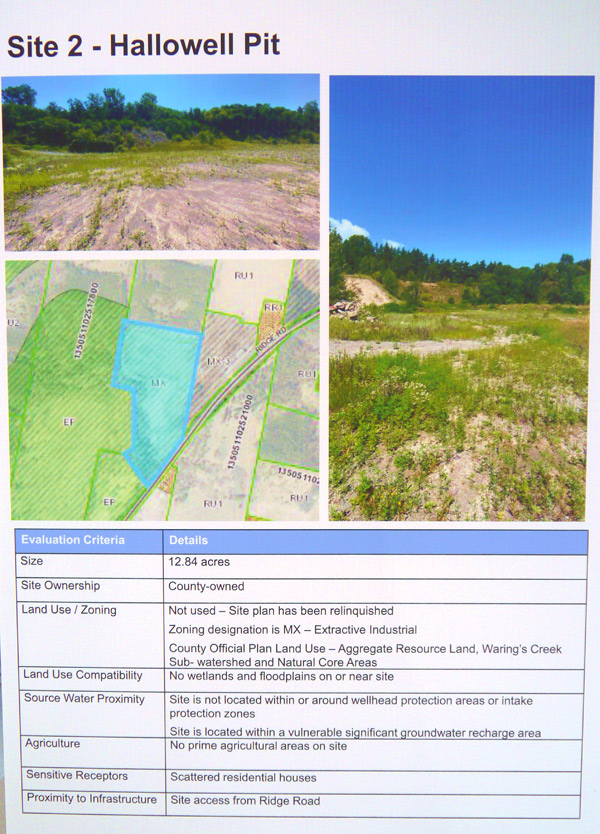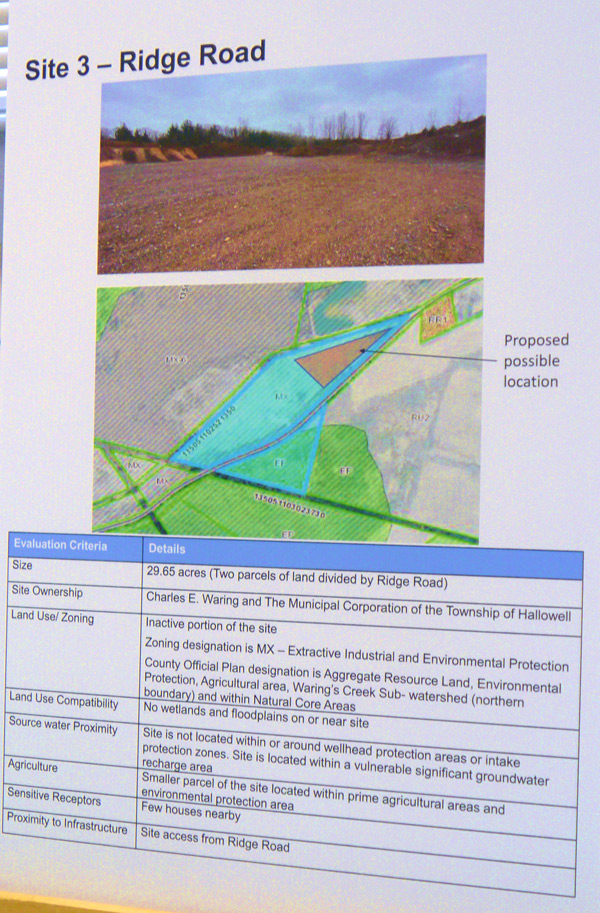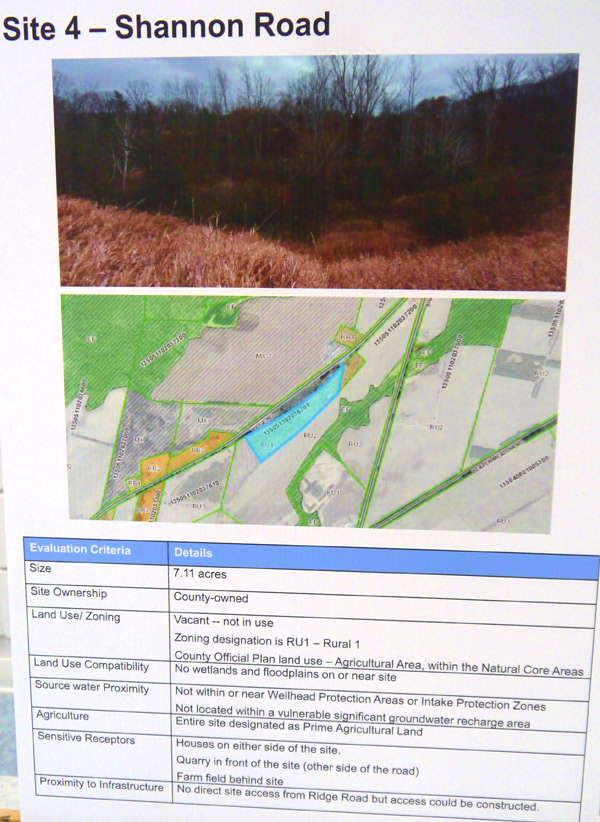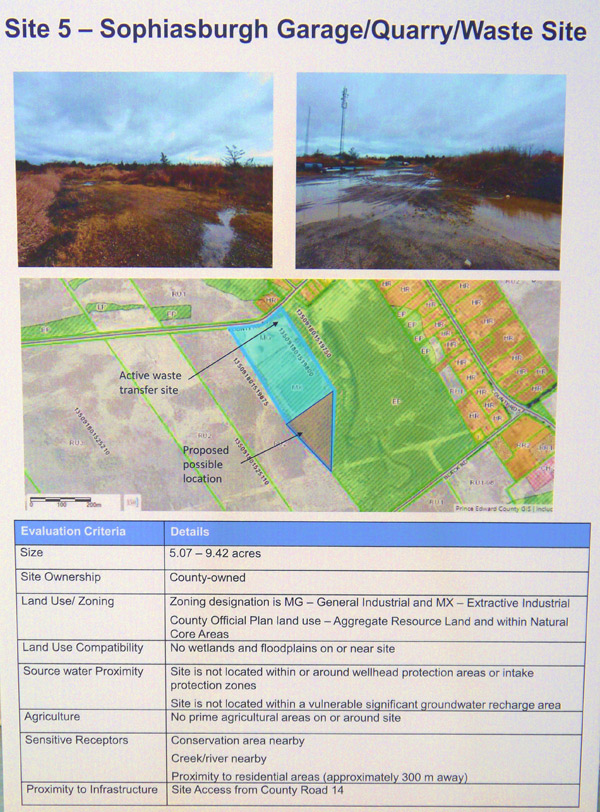County looking at five sites to bring green bin collection in-house
Administrator | Mar 28, 2024 | Comments 0
Story and photos by Sharon Harrison
It costs the municipality $250,000 to $300,000 every year to pick-up and dispose of some 780 tonnes of food waste in its curbside collection – amounts that are expected to rise significantly in the coming years.
The construction of a County-operated facility is an option being considered to potentially mitigate increased costs going forward.
Details of five long-listed municipal sites being considered for a proposed organics waste management facility in the County were on display at the Prince Edward Community Centre in Picton Wednesday, giving the public the opportunity to review, ask questions and provide feedback.
The idea behind the feasibility study is to evaluate the current organics waste program in an effort to save the municipality, and the taxpayer, money as the cost of running the program is anticipated to increase due to population growth, potential participation increase and contractor costs.
Wednesday’s meeting was the third of three public information meetings held on the proposed organics waste site study, with separate meetings being held last week at North Marysburgh Town Hall and Sophiasburgh Town Hall.
Hosted by the municipality, the public consultation included display boards, as well as a short presentation by Albert Paschkowiak, the County’s environmental services and sustainability supervisor, who was accompanied by Axita Patel, a solid waste planner with consulting firm GHD from Mississauga.
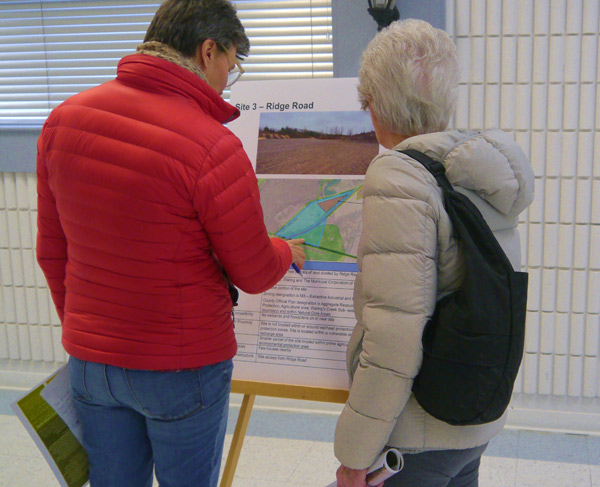 Around 20 people come out Wednesday to learn more about the project, with organizers confirming about 15 attended in Waupoos last week, and 10 in Demorestville.
Around 20 people come out Wednesday to learn more about the project, with organizers confirming about 15 attended in Waupoos last week, and 10 in Demorestville.
Several residents in attendance Wednesday identified as living near one of the proposed sites and were concerned about property values being affected. A few others spoke to noise and odours. One person enquired if it would be more profitable for the County to sell a potential site, and buy a cheaper site elsewhere.
Paschkowiak went over the criteria used to evaluate the five chosen sites, where he gave an overview of why the feasibility study was done, and how the study evaluates suitable available locations, as well as the technology for managing organics. He also spoke a bit about the current organics waste collection in the County.
The five sites being considered are the former waste site at North Marysburgh (Waupoos), the former Hallowell pit, the Ridge Road pit, the former pit on Shannon Road, and the Sophiasburgh garage/waste site.
He explained that council approved the request (and the funds) for the preparation of a feasibility study in 2022 for a municipal organics management facility, an option that is being explored because of the substantial cost associated with dealing with organics.
“It is a significant expense to the municipality every year to fill those green bins, and take them away, and have the material just disappear,” said Paschkowiak, stating that the idea here is to investigate whether the disposal of organic waste could be done in the County, and for less money.
“Could we do it and reap the benefits that come from doing something like this?” he asked.
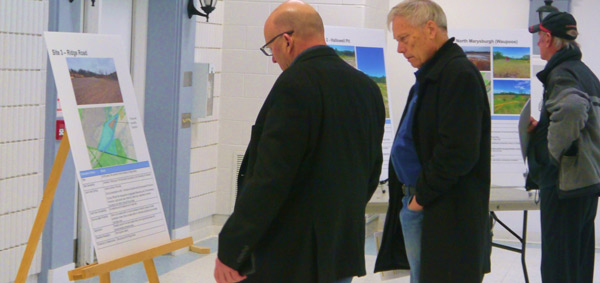 Paschkowiak explained that the first step they took in the process was to look at municipally-owned properties, as a “cost-conscious option to save money”, and that was followed by an evaluation, with this step receiving feedback from the public.
Paschkowiak explained that the first step they took in the process was to look at municipally-owned properties, as a “cost-conscious option to save money”, and that was followed by an evaluation, with this step receiving feedback from the public.
He stressed that it is still early in the process and just the first part of the entire process, and there would be further opportunity for the public to attend another information meeting, likely in the summer.
The current organics waste program in place deals with 780 tonnes of food waste per year, something Paschkowiak reminds comes with a big cost, and while not everybody uses the program, he said some people do still put organics waste material in with their garbage.
“That’s a problem, it generates green house gas emissions. It wastes space in current landfills, and we all know space is at a premium, so we can’t afford to just throw it away.”
The cost to run the current program is $250,000 to $300,000 per year, and is projected to increase as population increases. It was noted that half of that cost annually goes to contracted disposal costs.
“The idea here is, can we do this and not be subjected to those cost pressures.”
There is a missed opportunity with this material, he said, “It generates great compost that is perfect for farmers’ fields, people’s vegetable gardens, and so on.”
He said, ensuring compost stays in the County reduces reliance on chemical fertilizers and positively impacts the local nutrient cycle.
“The intent of this study is to chose a site and a technology that is able to generate quality AA compost, which is the highest quality compost that you can get, and the idea with that is it is the most usable, so that we can give it out to the most amount of people as regulation doesn’t prevent us from giving it to folks to use.”
He did address one question he said has come up, and that is, if the program is so expensive to run, why doesn’t the municipality stop offering the service altogether? Paschkowiak explained the reason is because the municipality is mandated to keep the program, according to the Food and Organic Waste Policy Statement issued by the Ministry of the Environment, Conservation and Parks.
“We have established this program some time ago [approx. 2014], and because it’s in place, we are unable to decrease it; we must maintain it or improve it,” he said.
He said some municipalities who don’t have green bin collection will be forced to have green bin collection going forward.
“The ministry is considering a ban on organics in landfills, and if that happens, we will have to have somewhere to take it,” he added.
“The intent is to reduce our costs, fix our costs in the future, preserve vital landfill space, reduce our greenhouse gas emissions; when this material goes to landfill, when it breaks down, it will generate methane, which is several times worse than CO2.”
Next steps are a site evaluation, short list review, identifying a preferred site (or sites), technology review and selection, environmental review by the minister of environment, preliminary design, preliminary cost analysis and then to council for approval.
The short list evaluation exclusionary criteria will look proximity to sensitive receptors, travel distances, compatibility with existing land uses, etc. and will consider potential effects, mitigation measures and net effects, comparing sites against each other and ranking them.
Site suitability will include minimum size requirements, and will avoid sensitive receptors (residential areas, parks, recreational areas, etc.) and wetlands, floodplains, prime agricultural lands, cultural heritage features, water source protection areas.
It is expected the short-list will be narrowed down to two or three sites.
Additional public consultation will come once a site proposal and preferred technology is established, along with the evaluation component, where a further public meeting is expected to be held in August when the results will be presented.
It is anticipated the proposal will then come before council in September.
More information about the organics processing feasibility study can be found on the County’s, where feedback from residents is encouraged to help facilitate the process.
Filed Under: Featured Articles • Local News
About the Author:



